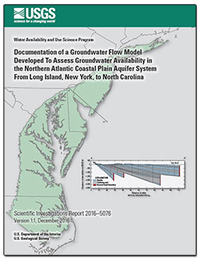Documentation of a groundwater flow model developed to assess groundwater availability in the Northern Atlantic Coastal Plain aquifer system from Long Island, New York, to North Carolina
Links
- Document: Report (26.5 MB pdf)
- Related Works:
- Data Series 996 - Digital Elevations and Extents of Regional Hydrogeologic Units in the Northern Atlantic Coastal Plain Aquifer System From Long Island, New York, to North Carolina
- Fact Sheet 2016–3046 - Sustainability of Groundwater Supplies in the Northern Atlantic Coastal Plain Aquifer System
- Professional Paper 1829 - Assessment of Groundwater Availability in the Northern Atlantic Coastal Plain Aquifer System From Long Island, New York, to North Carolina
- Scientific Investigations Report 2016–5034 - Regional Chloride Distribution in the Northern Atlantic Coastal Plain Aquifer System From Long Island, New York, to North Carolina
- Data Releases:
- USGS data release - MODFLOW-NWT model
- USGS data release - Digital elevations and extents of hydrogeologic units
- Project Site: USGS Water Availability and Use Science Program
- Version History: Version History (1 KB txt)
- Download citation as: RIS | Dublin Core
Abstract
The U.S. Geological Survey developed a groundwater flow model for the Northern Atlantic Coastal Plain aquifer system from Long Island, New York, to northeastern North Carolina as part of a detailed assessment of the groundwater availability of the area and included an evaluation of how these resources have changed over time from stresses related to human uses and climate trends. The assessment was necessary because of the substantial dependency on groundwater for agricultural, industrial, and municipal needs in this area.
The three-dimensional, groundwater flow model developed for this investigation used the numerical code MODFLOW–NWT to represent changes in groundwater pumping and aquifer recharge from predevelopment (before 1900) to future conditions, from 1900 to 2058. The model was constructed using existing hydrogeologic and geospatial information to represent the aquifer system geometry, boundaries, and hydraulic properties of the 19 separate regional aquifers and confining units within the Northern Atlantic Coastal Plain aquifer system and was calibrated using an inverse modeling parameter-estimation (PEST) technique.
The parameter estimation process was achieved through history matching, using observations of heads and flows for both steady-state and transient conditions. A total of 8,868 annual water-level observations from 644 wells from 1986 to 2008 were combined into 29 water-level observation groups that were chosen to focus the history matching on specific hydrogeologic units in geographic areas in which distinct geologic and hydrologic conditions were observed. In addition to absolute water-level elevations, the water-level differences between individual measurements were also included in the parameter estimation process to remove the systematic bias caused by missing hydrologic stresses prior to 1986. The total average residual of –1.7 feet was normally distributed for all head groups, indicating minimal bias. The average absolute residual value of 12.3 feet is about 3 percent of the total observed water-level range throughout the aquifer system.
Streamflow observation data of base flow conditions were derived for 153 sites from the U.S. Geological Survey National Hydrography Dataset Plus and National Water Information System. An average residual of about –8 cubic feet per second and an average absolute residual of about 21 cubic feet per second for a range of computed base flows of about 417 cubic feet per second were calculated for the 122 sites from the National Hydrography Dataset Plus. An average residual of about 10 cubic feet per second and an average absolute residual of about 34 cubic feet per second were calculated for the 568 flow measurements in the 31 sites obtained from the National Water Information System for a range in computed base flows of about 1,141 cubic feet per second.
The numerical representation of the hydrogeologic information used in the development of this regional flow model was dependent upon how the aquifer system and simulated hydrologic stresses were discretized in space and time. Lumping hydraulic parameters in space and hydrologic stresses and time-varying observational data in time can limit the capabilities of this tool to simulate how the groundwater flow system responds to changes in hydrologic stresses, particularly at the local scale.
Suggested Citation
Masterson, J.P., Pope, J.P., Fienen, M.N., Monti, Jack Jr., Nardi, M.R., and Finkelstein, J.S., 2016, Documentation of a groundwater flow model developed to assess groundwater availability in the Northern Atlantic Coastal Plain aquifer system from Long Island, New York, to North Carolina (ver. 1.1, December 2016): U.S. Geological Survey Scientific Investigations Report 2016–5076, 70 p., https://dx.doi.org/10.3133/sir20165076.
ISSN: 2328-0328 (online)
Study Area
Table of Contents
- Abstract
- Introduction
- Model Design
- Summary
- References Cited
| Publication type | Report |
|---|---|
| Publication Subtype | USGS Numbered Series |
| Title | Documentation of a groundwater flow model developed to assess groundwater availability in the Northern Atlantic Coastal Plain aquifer system from Long Island, New York, to North Carolina |
| Series title | Scientific Investigations Report |
| Series number | 2016-5076 |
| DOI | 10.3133/sir20165076 |
| Edition | Version 1.0: Originally posted August 31, 2016; Version 1.1: December 23, 2016 |
| Publication Date | August 31, 2016 |
| Year Published | 2016 |
| Language | English |
| Publisher | U.S. Geological Survey |
| Publisher location | Reston, VA |
| Contributing office(s) | New England Water Science Center, South Atlantic Water Science Center |
| Description | Report: vi, 70 p.; Data Releases |
| Public Comments | Version 1.1 |
| Country | United States |
| State | Delaware, Maryland, New Jersey, New York, North Carolina, Virginia |
| Other Geospatial | Northern Atlantic Coastal Plain aquifer system |
| Online Only (Y/N) | Y |
| Additional Online Files (Y/N) | Y |


